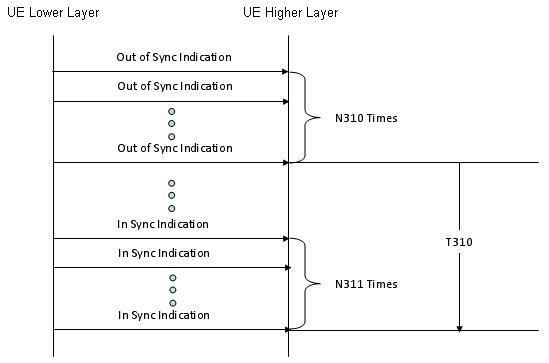|
T310
In LTE, timers and constants such as T310, N310, and N311 are critical parameters used in the management of radio link failure (RLF). They help the UE (User Equipment) monitor and recover from physical layer issues in RRC_CONNECTED state.

Note 1 : one "Out of Sync Indication" in this diagram means "20 subframes of consecutive PDCCH decoding failure.
Note 2 : one "In Sync Indication" in this diagram means "10 subframes of consecutive PDCCH decoding success.
T310
T310 is a timer started by the UE upon detecting consecutive "out-of-sync" indications for the PCell (Primary Cell) from lower layers (physical layer). It supervises the time the UE waits for conditions to improve or a recovery response from the network before declaring radio link failure.
When T310 is Started:
- Upon receiving N310 consecutive "out-of-sync" indications for the PCell while:
- T300, T301, T304, T311, or T316 is not running.
- For DAPS (Dual Active Protocol Stack) handovers, T304 is running, and N310 consecutive "out-of-sync" indications are received for the source PCell.
When T310 is Stopped:
- Upon receiving N311 consecutive "in-sync" indications for the PCell from the lower layers while T310 is running.
- This indicates recovery of the radio link without the need for additional signaling.
Expiry of T310:
- If T310 expires, the UE declares radio link failure (RLF) and:
- Initiates the RRC connection re-establishment procedure as per clause 5.3.7.
- Stores relevant RLF information for reporting (e.g., measurements of the failed cell and neighboring cells).
N310
N310 is a configurable constant that specifies the number of consecutive "out-of-sync" indications the UE must receive from the lower layers before taking action (e.g., starting T310).
Behavior:
- Upon receiving N310 consecutive "out-of-sync" indications:
- The UE considers the radio link to be in a degraded state.
- Starts T310 to monitor whether the situation recovers within the timer's duration.
N311
N311 is a configurable constant that specifies the number of consecutive "in-sync" indications the UE must receive from the lower layers to consider the radio link as recovered.
Behavior:
- Upon receiving N311 consecutive "in-sync" indications while T310 is running:
- The UE stops T310.
- The UE considers the radio link to have recovered and maintains the current RRC connection without additional signaling.
Radio Link Failure Management Workflow
Detection of Degraded Link (N310 and T310):
- The UE monitors the "sync" status provided by the physical layer:
- "Out-of-sync": The link quality between the UE and the PCell is insufficient.
- Upon N310 consecutive "out-of-sync" indications, the UE starts T310 to supervise the degraded state.
Recovery Monitoring (N311):
- While T310 is running, the UE continues to monitor for recovery indications:
- "In-sync": Indicates improved link quality.
- If the UE receives N311 consecutive "in-sync" indications, T310 is stopped, and the radio link is considered recovered.
Radio Link Failure (RLF):
- If T310 expires without receiving N311 consecutive "in-sync" indications:
- The UE declares radio link failure.
- It initiates the RRC connection re-establishment or takes appropriate failure-handling actions.
Reconfiguration of T310, N310, and N311
The values for T310, N310, and N311 can be dynamically reconfigured by the network via the rlf-TimersAndConstants parameter. This allows the network to adjust failure detection sensitivity based on conditions like load, mobility, or interference.
- Release Scenario:
- If rlf-TimersAndConstants is set to release:
- The UE uses the default values specified in ue-TimersAndConstants in SystemInformationBlockType2.
- Reconfiguration Scenario:
- If rlf-TimersAndConstants provides new values:
- The UE updates the timers and constants to the received values.
Interaction Between T310, N310, and N311
- N310 and N311 thresholds act as triggers to start and stop T310.
- T310 acts as a time boundary:
- Ensures that the UE doesn't wait indefinitely for recovery when N310 is met.
- Allows sufficient time for N311 to indicate recovery when conditions improve.
|
|
